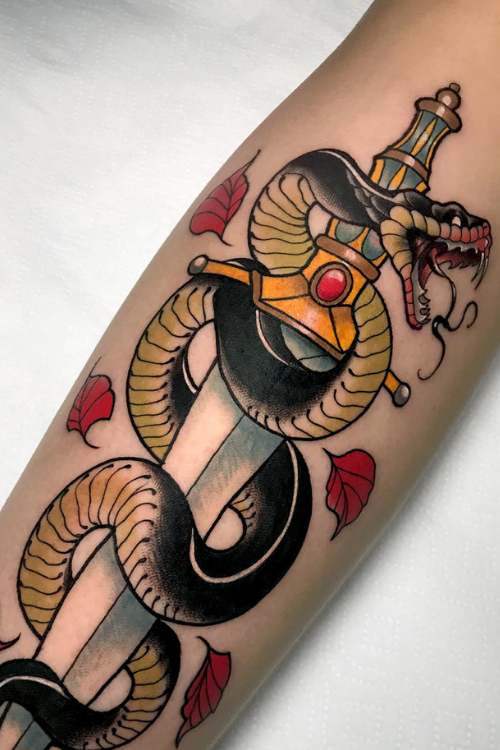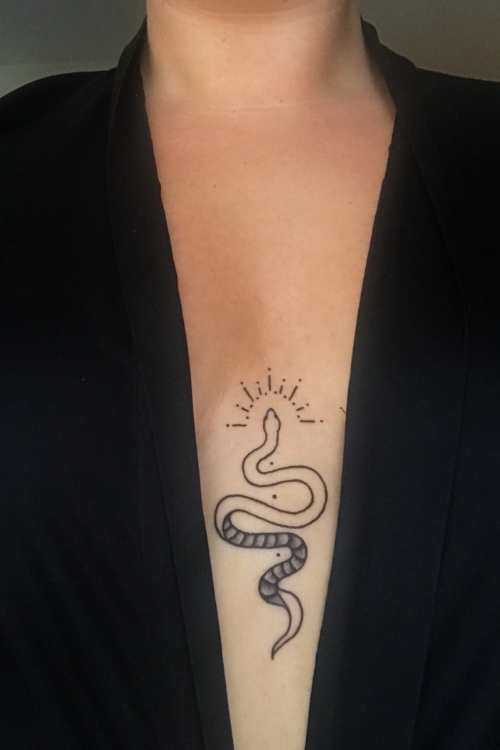Physical Address
Minuwangoda ,Sri Lanka.
Physical Address
Minuwangoda ,Sri Lanka.

Snake tattoos have a rich history and symbolism that date back centuries, captivating people with their allure and mystery. These iconic designs, adorned by countless individuals across cultures and generations, carry profound meanings that delve deep into the human psyche. As one of the most ancient and enduring symbols, snakes have been revered and feared, celebrated and demonized, embodying a spectrum of emotions and concepts.
From the ancient civilizations of Egypt and Mesopotamia to the Norse myths of Scandinavia and the indigenous cultures of the Americas, snakes have played a significant role in human culture and spirituality. Their representation in tattoo art reflects a tapestry of beliefs, stories, and interpretations that continue to evolve in the contemporary world.
In this exploration, we journeyed to unravel the symbolism behind snake tattoos. We delve into the historical significance of these serpentine designs, tracing their cultural meanings across different societies. Furthermore, we examine the contemporary interpretations of snake tattoos, considering how they resonate with individuals in today’s diverse and interconnected world.
Join us as we peel back the layers of symbolism and meaning, uncovering the hidden depths of snake tattoos and their profound messages about identity, spirituality, and the human experience.
Before delving into the meaning of snake tattoos, it’s crucial to understand the broader symbolism associated with snakes. Across cultures and throughout history, snakes have been imbued with multifaceted meanings that reflect both human existence’s light and dark aspects.
At its core, the snake symbolizes transformation and renewal. Shedding its skin, the snake undergoes a process of rebirth, emerging anew and revitalized. This cyclic shedding represents the eternal cycle of life, death, and rebirth, making the snake a potent symbol of regeneration and transformation.
Moreover, snakes are often associated with duality and ambiguity. With their ability to slither effortlessly between worlds, snakes inhabit the liminal spaces between the earthly and the divine, the conscious and the unconscious. This duality is reflected in various mythologies and belief systems, where snakes serve as mediators between realms, embodying both benevolent and malevolent forces.
In many cultures, snakes are revered as symbols of wisdom and knowledge. From the serpent in the Garden of Eden tempting Adam and Eve with forbidden knowledge to the serpent deity Quetzalcoatl in Mesoamerican mythology, snakes are often depicted as custodians of esoteric wisdom and mystical insight. Their sinuous form and penetrating gaze evoke a sense of ancient wisdom that transcends human understanding.
However, snakes also carry connotations of danger and deceit. Their venomous bite and stealthy movements have earned them a reputation as symbols of treachery and betrayal. In folklore and literature, snakes are often portrayed as cunning and deceitful creatures, capable of luring unsuspecting victims into their grasp with promises of power or enlightenment.
In contemporary culture, snakes continue to fascinate and intrigue, their symbolism evolving to reflect the complexities of modern life. From the sleek and stylized serpent motifs in fashion and design to the edgy and rebellious snake tattoos sported by celebrities and influencers, snakes remain a potent symbol of mystery, power, and transformation in the collective imagination.
In the realm of tattoo art, snake tattoos serve as powerful symbols of personal growth, resilience, and inner strength. By adorning their bodies with snake imagery, individuals embrace the transformative power of the serpent, celebrating their ability to shed the old and embrace the new. Whether as a bold statement of defiance or a subtle nod to the mysteries of life, snake tattoos continue to captivate and inspire, inviting us to explore the depths of our inner landscape.
Snake imagery in tattoo art has been prevalent across various cultures throughout history, each imbuing the serpent with its unique significance. From the ancient civilizations of Egypt and Mesopotamia to the indigenous tribes of Africa and the Americas, snakes have played a central role in religious rituals, mythologies, and folklore, leaving an indelible mark on the collective consciousness of humanity.


In Ancient Egypt, the serpent was revered as a symbol of protection and divine power. The goddess Wad jet, often depicted as a cobra, was believed to guard the pharaoh and protect the kingdom from harm. As a symbol of royalty and sovereignty, the snake adorned the crowns of Egyptian rulers, signifying their divine authority and connection to the gods.
Similarly, in Mesopotamian mythology, the serpent was associated with fertility, wisdom, and the cycle of life and death. The Sumerian god Ningizzida, depicted as a serpent with wings, was worshipped as a guardian of the underworld and a mediator between the realms of the living and the dead. Snakes were also depicted in Babylonian art and literature, symbolizing the chaos and primordial forces of creation.
In the Americas, snakes held sacred significance among indigenous tribes, often representing fertility, healing, and spiritual transformation. The Aztecs worshipped Quetzalcoatl, the feathered serpent god, as a symbol of wisdom, enlightenment, and the cycle of rebirth. Meanwhile, the Maya revered the snake as a symbol of rain, fertility, and renewal, depicting the serpent god Kukulkan in their temples and monuments.
Across Europe, snakes were both feared and revered, often associated with pagan rituals and fertility cults. In Norse mythology, the serpent Jormungandr encircled the world, symbolizing the cyclical nature of existence and the eternal struggle between order and chaos. Snakes were also prominent in Celtic mythology, where they were believed to possess healing powers and prophetic wisdom.
As tattooing practices spread across the globe, so too did the tradition of snake tattoos. Sailors and explorers, inspired by the exotic cultures they encountered, adopted snake tattoos as symbols of protection and good fortune. In the early days of modern tattooing, snake tattoos were popular among circus performers and sideshow attractions, reflecting the allure of the mysterious and the exotic.
Today, snake tattoos continue to evoke the rich tapestry of human history and mythology, serving as timeless symbols of power, transformation, and spiritual awakening. Whether as a homage to ancient traditions or a personal expression of identity and belief, snake tattoos remind us of our connection to the natural world and the enduring mysteries of the human spirit.
Different cultures have interpreted the snake symbol differently, resulting in a diverse range of meanings associated with snake tattoos. Across continents and civilizations, snakes have been revered, feared, and mythologized, reflecting the complex relationship between humanity and these enigmatic creatures.
In ancient Egypt, the snake held a prominent place in religious and spiritual practices. The serpent goddess Wadjet, depicted as a cobra, was worshipped as a protector of the pharaoh and a guardian of the kingdom. The ouroboros, a symbol of a serpent eating its tail, represented the eternal cycle of life, death, and rebirth, reflecting the Egyptians’ belief in the cyclical nature of existence.
In Norse mythology, the serpent Jormungandr, also known as the Midgard Serpent, encircled the world, representing the cosmic forces of chaos and destruction. Despite its malevolent nature, the serpent was also seen as a symbol of transformation and renewal, embodying the cyclical nature of life and the eternal struggle between order and chaos.
Among indigenous tribes in the Americas, snakes held sacred significance, often representing fertility, healing, and spiritual transformation. The Aztecs worshipped Quetzalcoatl, the feathered serpent god, as a symbol of wisdom, enlightenment, and the cycle of rebirth. Similarly, the Maya revered the snake as a symbol of rain, fertility, and renewal, associating it with the cycle of life and the agricultural calendar.
In Asian cultures, snakes were often associated with wisdom, longevity, and prosperity. In Chinese mythology, the snake is one of the twelve zodiac animals, representing intuition, cunning, and resourcefulness. In Hinduism, the serpent deity Naga is worshipped as a guardian of treasures and a symbol of fertility and protection.
In modern times, snake tattoos continue to hold profound meaning for many individuals, often reflecting personal beliefs, experiences, or characteristics. As society evolves and cultural perspectives shift, the symbolism associated with snake tattoos has also evolved, resonating with contemporary themes of identity, empowerment, and self-expression.
One of the most prominent contemporary interpretations of snake tattoos is their representation of resilience and transformation. In a world marked by rapid change and uncertainty, the snake’s ability to shed its skin and emerge anew serves as a powerful metaphor for personal growth and renewal. For many, a snake tattoo symbolizes their journey of overcoming adversity, embracing change, and embracing the opportunity for transformation.
Moreover, snake tattoos are often seen as symbols of strength and empowerment. With their sleek and sinuous form, snakes exude a sense of power and confidence, inspiring individuals to tap into their inner strength and resilience. Whether as a bold statement of defiance or a subtle affirmation of self-assurance, snake tattoos empower individuals to embrace their unique qualities and embrace their inner power.
Beyond their cultural and historical significance, snake tattoos can also hold symbolic value in the realm of mental health and personal growth. The decision to adorn one’s body with a snake tattoo can be deeply personal and meaningful, reflecting an individual’s journey of self-discovery, healing, and empowerment.
One psychological perspective on snake tattoos is their association with transformation and resilience. Just as snakes shed their old skin to make way for new growth, individuals may choose to get a snake tattoo as a symbol of their own journey of transformation and renewal. Whether overcoming past trauma, navigating life transitions, or embracing personal growth, the snake tattoo serves as a tangible reminder of one’s ability to adapt and thrive in the face of adversity.
Moreover, snake tattoos can also serve as symbols of empowerment and reclaiming agency. For individuals struggling with mental health issues such as anxiety, depression, or PTSD, getting a snake tattoo can be a way of asserting control over their bodies and experiences. By choosing to adorn themselves with a symbol of strength and resilience, individuals can reclaim ownership of their narratives and redefine their sense of self in a positive and empowering way.
Furthermore, snake tattoos may also hold therapeutic value as a form of self-expression and catharsis. For some individuals, the act of getting a tattoo can be a deeply cathartic experience, allowing them to externalize and process complex emotions or experiences. By transforming their pain or struggles into a tangible work of art, individuals can find healing and closure, turning their scars into symbols of strength and resilience.
In addition, snake tattoos can serve as symbols of inner wisdom and intuition. Snakes are often associated with qualities such as intuition, instinct, and foresight, serving as guides on the journey of self-discovery and personal growth. By embracing the symbolism of the serpent, individuals can tap into their inner wisdom and intuition, gaining insight into their deepest desires, fears, and aspirations.
Overall, snake tattoos hold profound psychological significance for many individuals, serving as symbols of transformation, empowerment, and self-discovery. Whether as a reminder of past struggles, a symbol of inner strength, or a catalyst for personal growth, snake tattoos offer a powerful means of expression and healing for those navigating the complex terrain of mental health and well-being.
In addition, snake tattoos can also be interpreted as symbols of mystery and intrigue. With their enigmatic allure and potent symbolism, snakes have long captured the imagination of artists, writers, and creatives. In tattoo art, snakes are often depicted in stylized and symbolic forms, inviting viewers to contemplate their deeper meanings and associations. From minimalist snake silhouettes to intricate serpent coiling designs, each tattoo carries its unique symbolism, inviting the viewer to unravel its hidden depths.
Furthermore, snake tattoos are increasingly embraced as symbols of individuality and self-expression. In a world where conformity often reigns supreme, snake tattoos offer a canvas for individuals to express their unique personalities, beliefs, and experiences. Whether as a homage to ancient traditions or a personal expression of identity, snake tattoos allow individuals to make a bold and meaningful statement about who they are and what they stand for.
Snake tattoos have transcended gender boundaries and are increasingly popular among women, offering a unique avenue for self-expression and empowerment. In contemporary tattoo culture, snake tattoos for women carry a rich tapestry of symbolism that reflects both feminine strength and mystique.
Historically, snakes have been associated with feminine energy and fertility in many cultures. In ancient mythology, serpent goddesses such as Wad jet in Egypt and Nagini in Hinduism symbolize feminine power, wisdom, and protection. The serpent’s ability to shed its skin also evokes themes of rebirth and regeneration, mirroring the cyclical nature of femininity and the transformative journey of womanhood.
For many women, snake tattoos serve as symbols of empowerment and resilience. The serpent’s sleek and sinuous form exudes a sense of strength and confidence, inspiring women to embrace their inner power and assertiveness. Whether as a bold statement of defiance or a subtle nod to feminine strength, snake tattoos allow women to reclaim agency over their bodies and identities in a society that often seeks to diminish or objectify them.
Moreover, snake tattoos can also embody themes of sensuality and allure. The serpent’s serpentine movements and penetrating gaze evoke a sense of mystery and intrigue, drawing viewers into their hypnotic spell. In tattoo art, snakes are often depicted in elegant and feminine forms, accentuating their beauty and grace. For women seeking to celebrate their femininity and sensuality, a snake tattoo can be a powerful symbol of self-confidence and self-love.
Furthermore, snake tattoos can serve as symbols of transformation and self-discovery for women navigating life’s challenges and transitions. Just as snakes shed their old skin to make way for new growth, women may choose to get a snake tattoo as a reminder of their journey of personal growth and renewal. Whether overcoming past trauma, embracing their sexuality, or pursuing their dreams, snake tattoos offer women a tangible symbol of resilience and transformation.
Snake tattoos come in a variety of designs, each carrying its own unique symbolism and aesthetic appeal. From minimalist serpent silhouettes to elaborate coiling designs, the versatility of snake tattoos allows individuals to express themselves in a myriad of ways. Let’s delve into some of the most popular snake tattoo designs and their meanings:



Snake tattoos have made a significant impact in pop culture and media, appearing in various forms of entertainment, fashion, and art. From iconic film characters to influential musicians, the serpent’s symbolism has permeated popular culture, leaving an indelible mark on the collective imagination.
Here are answers to some common questions about snake tattoos and their symbolism: